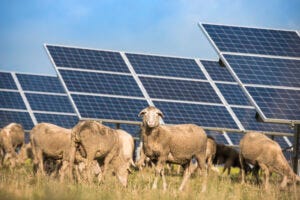Growing green energy and greener crops
Alberta got one piece of its new policy right
Now that the Government of Alberta has lifted the moratorium on renewable energy project approvals, clean energy companies are left to figure out the details, which even the Minister responsible for the rules admits still needs some work.
In her press conference announcing the new policy, Premier Danielle Smith stressed that the province was taking an “agriculture first” approach. The value of agrivoltaics has been a prominent part of the talking points leading up to the announcement and as part of the government's messaging since. Simply put, the term means finding a balance between solar power installations and the ongoing productivity of agricultural under and near the solar panels.
It is a good approach to developing renewable energy and is a solid goal – even with ‘details to follow’.
Implementing agrivoltaics is catching on as farmers find that synchronicity can be achieved with some careful planning. A project in Colorado spaced 3,200 solar panels to allow for the planting of vegetables in between rows. Because of the microclimate created by the panels, not only did the crops thrive, but they used less irrigation water and the evaporation helped cool the solar panels. This symbiotic practice is relatively new, but as Agrivoltaics Canada notes, solar power generation provides revenue while maintaining or even increasing crop yields. Crops such as corn, lettuce, potatoes, tomatoes, wheat and pasture grass when integrated around solar panels, have been shown to increase the overall economic value of a project by as much as 30 percent. The Ivey Centre for Building Sustainable Value suggests that 1% or Canadian land would support 25% of our electrical energy needs if agrivoltaics were integrated into solar projects.
It isn’t just crops that can be integrated into a solar project.
With proper planning, sheep or cattle can benefit from the shade produced by panels. Tune into the “Flock Talk” podcast to hear how agrivoltaics works for ag producers. In a field study by the West Central Research and Outreach Center in the United States, there were no negative effects on cattle grazing around solar panels, and that the shade from an agrivoltaic system may reduce the effects of heat stress in pastured dairy cows. The American Solar Grazing Association estimates that 50,000 acres of solar farms accommodated sheep grazing last year.
There is also the question of space because solar farms need a lot it. A new project in PEI for instance covers 68 acres, but it is 68 acres of a well-field which cannot be used for any other development because it is a significant source of groundwater for the municipality. The idea of a dual-purpose facility is one of the side-bar advantages of solar power and agrivoltaics has a solid business case in that mix.
A five-year study in the US found that native insect populations grew in numbers and diversity. In particular, pollinators such as bees and wasps thrived and spread to nearby fields. Globally insect numbers are down, so as more renewables facilities are built, the more opportunities there are to create habitat for beneficial insects. One could easily imagine beekeeping being added to the agricultural and renewable power mix and the Center for Rural Affairs laid out some basics.
The equation is surprisingly simple. Producers can reap the income (or the energy) from a solar panel field, grow crops around the panels, provide shade for livestock, and help maintain biodiversity. The new Alberta policy for renewable energy projects didn’t get it all right, but it at least pointed in the right direction.


